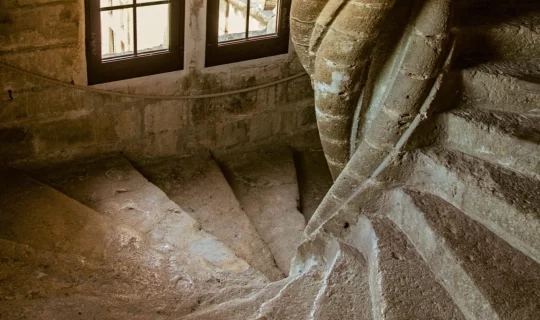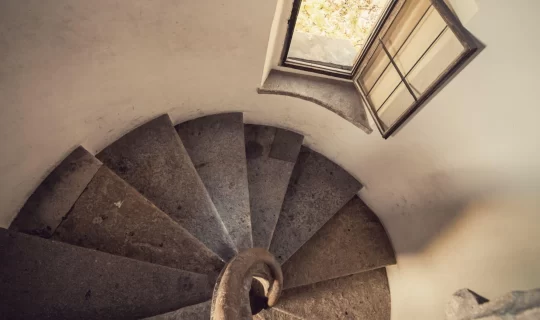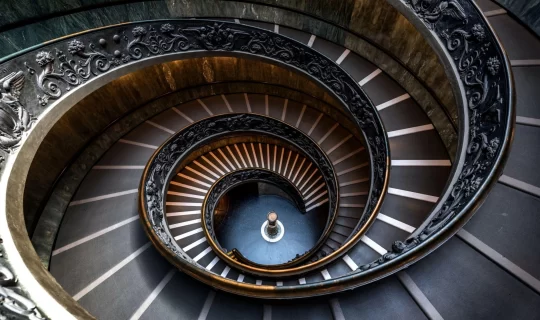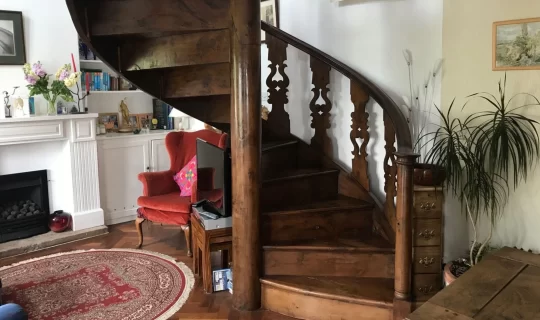The history of the spiral staircase
Think the spiral staircase is a modern-day phenomenon? Think again.
The spiral staircase is a design that is such a common and well-loved feature of modern buildings that many people do not realise that they have such a long and rich heritage. In fact, the history of the spiral staircase stretches back thousands of years.

In the Old Testament, there is a reference to spiral staircases being a feature in the Temple of Solomon. This could suggest that they were already in use by around 1,000 years BC.
Temple A at Selinunte in Sicily was constructed around 480 BC and at this site the remains of an early form of spiral staircase have been found.
The oldest spiral staircase that is still standing today can be found in Rome. This is at Trajan’s Column which was built in 113 AD. A total of 185 steps took people from ground level up inside the 35 metre column. At the top of this there was a platform from which visitors could enjoy a sweeping panoramic view of Rome. Around this time, spiral staircases began to find much wider use in Roman architecture.
The earliest spiral staircases were carved out of stone or marble and built directly into the walls of the building to support their weight. It took some time for the spiral staircase design that we would recognise today to develop, a more freestanding structure with the steps built around a central newel or pole. From Roman times onward, spiral staircases started to exhibit many of the classic features that we would recognise today.
The influence of the Romans helped to introduce the spiral staircase more widely into building design across Europe. Then throughout the Middle Ages they became a well-established feature of many castles, in part due to the advantages they gave in helping to defend against attackers.
With spiral staircases being quite narrow, it was impossible to launch a mass assault, as any attackers would have to ascend one at a time, with little space available for wielding weapons. Furthermore, for those ascending, the spiral staircase in a castle would be designed to turn in a clockwise direction. This meant that their right hand (their sword arm) would be tight against the narrowest part of the stairs, close to the central pole. This made it almost impossible for the attacker to use their sword effectively. In contrast, those defending the castle had much more freedom of movement to strike downwards with their swords.
The castle defenders often had one other tactical advantage designed into their spiral staircase – in the form of uneven steps! Those living in the castle would be very familiar with the pattern of their stairs and could retreat up them very swiftly. However, the attackers were much more likely to stumble and fall, particularly in the dimly lit confines of the staircase.
With spiral staircases being associated with kings and castles, it is not surprising that they became a desirable feature for the wealthy to incorporate into their homes. An excellent example of this is the magnificent spiral staircase at the Chateau de Chambord in the Loire Valley, which was built in the early 16th Century. This takes the form of two spiral staircases, intertwined to form a double-helix. Many experts believe that this superb feat of design and engineering was the work of Leonardo da Vinci, who was living close by at the time of its construction.


Spiral staircases were also increasingly incorporated into churches and cathedrals. They were a very practical and space efficient way of ascending tall structures such as spires and bell towers. However, they also gave architects and builders an opportunity to add beauty and inspiration to their buildings, through the impressive use of spiral staircase design.
In the UK, one of the most notable examples is the Dean’s Staircase at St Paul’s Cathedral. Designed by Sir Christopher Wren, this world-famous staircase rises up to the Whispering Gallery. (Fans of Harry Potter will recognise this staircase immediately as it has featured in the movie versions of the books.)
Even in more recent cathedral design, the spiral staircase continues to play a prominent part. In Barcelona, Gaudi’s masterpiece, the Sagrada Familia, features a beautiful stone spiral staircase in its Passion Tower which attracts visitors from all over the world.
In Victorian times, cast iron spiral staircases became popular for homes and for public buildings. These were able to be designed to a customer’s specification and could be finished in a range of elaborate designs. These were not only functional and practical but also objects of beauty in their own right.
In the latter half of the 20th century, it became very cost effective to produce the frames for spiral staircases in steel. This made them affordable for a much wider market and they became a more frequent feature of modern houses and apartments. At the same time, the use of steel spiral staircases as fire escape stairs became widespread in many types of building.
Today, classic spiral staircases can be made in a wide variety of materials, including steel, wood, concrete and glass. The timeless appeal of their design means that they can be used to make a dramatic design statement in luxury homes, offices and public buildings, with a finish that can blend with virtually any type of interior design.

The spiral staircase continues to inspire architects right around the world. In Linzhou, China, a 300 foot spiral staircase has been constructed in order to give tourists a panoramic view of the Taihang Mountains.
The enduring appeal of spiral staircases looks set to continue well into the future.
For modern spiral staircase design ideas visit our spiral staircases page.